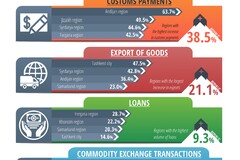To assess the economic situation in the country, the Center for Economic Research and Reforms conducts a monthly assessment of the state of business activity at the regional and district levels. The analysis is carried out on the basis of operational data of the State Customs Committee, the State Tax Committee, the Central Bank and the UzEx.
The monitoring results showed that the volume of tax revenues of the republic increased by 16.0% over the year. A significant increase in tax revenues was recorded in Jizzakh (by 34.3%), Samarkand (by 34.0%), Ferghana (by 33.4%), Syrdarya (by 30.9%), Bukhara (by 30.8%) regions, in the Republic of Karakalpakstan (by 33.2%) and in Tashkent (by 38.1%).
According to the CERR, the increase in tax revenues in general for 2022 was significantly influenced by the introduction of new digital tools: electronic invoice, online cash register, "Cashback", "E-ijara", "Solikchi kumakchi", "tax.gap", digital labeling of goods, national catalog (tasnif.soliq.uz) and others.
In terms of sources, turnover tax receipts increased by 152%, VAT by 128%, and income tax receipts by 157%, which allowed us to adjust the prerequisites and factors for maintaining this growth level until the end of the year.
Receipts on customs payments for the analyzed period increased by 38.5% compared to the same period in 2021. The largest increase in customs receipts was observed in Andijan (by 63.7%), Jizzakh (by 49.5%), Syrdarya (by 44.6%), Ferghana (by 42.5%) regions, in the Republic of Karakalpakstan (by 39.4%) and Tashkent (by 41.7%).
The analysis showed that over the past year, 7 information systems and 4 interactive services in the field of digitalization were put into operation.
In particular, the information system "Corruption Risk Management", aimed at minimizing corruption factors in the activities of customs authorities, and the information system "Customs and Cargo operations", aimed at creating a unified system of goods control based on the chain, were launched "border checkpoints".
Also, the information system "E-Archive" has been introduced, aimed at the electronic collection of these documents, as well as the interactive service "E-Navbat", aimed at organizing and expediting the passage of vehicles with export fruits and vegetables across the state border.
The volume of automatic processing of cargo declarations without human participation increased from 1.4% to 39%, and in exports it was 35%.
According to the State Customs Committee, the volume of exports of goods from the beginning of 2022 to December 31, 2022 increased by 21.1% compared to the same period last year. Significant export growth was observed in Syrdarya (by 42.8%), Andijan (by 36.4%), Samarkand (by 23.0%), Namangan (by 22.7%), Kashkadarya (by 22.3%) regions and Tashkent (by 47.5%).
The increase in Uzbekistan's exports is explained by the growing growth rates of exports of food products, industrial goods, chemicals and agri-food products.
Exports decreased in Surkhandarya (by -23.3%), Bukhara (by -2.1%), Jizzakh (by -1.1%), Tashkent (by -0.5%) regions and in the Republic of Karakalpakstan (by -13.6%).
The decrease in the volume of exports of Surkhandarya region is associated with a reduction in the export of yarn and fruit and vegetable products (beans, tomatoes, mash, onions), in the Bukhara region the direction of cotton fiber to the domestic market, in the Jizzakh region – a reduction in yarn exports, in the Tashkent region – a reduction in copper exports, and in the Republic of Karakalpakstan, a reduction in the export of plastics, pharmaceutical products and yarn.
The volume of loans issued by commercial banks in the period from January 1 to December 31, 2022 increased by 9.3% compared to the same period last year.
A significant increase in the issuance of loans was noted in Ferghana (by 28.7%), Khorezm (by 22.2%), Samarkand (by 20.3%), Tashkent (by 12.0%) regions, the Republic of Karakalpakstan (by 13.9%) and Tashkent (by 14.6%).
The volume of transactions on the UzEx for the analyzed period increased by 35.7%. A significant increase in exchange activity is observed in Khorezm (by 52.1%), Samarkand (by 46.9%), Navoi (by 46.7%), Jizzakh (by 37.9%) regions and in Tashkent (by 41.6%).
The growth in the volume of transactions in these regions is ensured by increasing the sale of such goods as mineral fertilizers, technical seeds, automobile gasoline, diesel fuel, construction and household materials, vegetable oil, wheat flour, wheat, sugar, cotton fiber, rolled ferrous and non-ferrous metals, polyethylene, polypropylene, ethyl alcohol, etc.
During the analyzed period, 87,613 new economic entities were created, the largest number of which were registered in Samarkand (9,724), Ferghana (8,664), Kashkadarya (8,150), Tashkent (6,771), Khorezm (5,439) regions and in Tashkent (15,441).
Muhammadjon Rashidov, CERR






















leave a comment